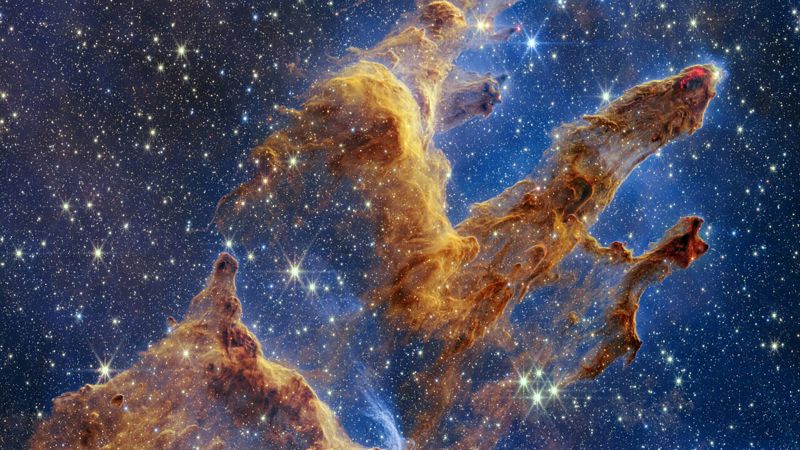
Sign up for CNN’s Wonder Theory science newsletter. Explore the universe with news on fascinating discoveries, scientific advancements and more.
CNN
—
The James Webb Space Telescope captured a highly detailed snapshot of the so-called Pillars of Creation, a vista of three looming towers made of interstellar dust and gas that’s speckled with newly formed stars.
The area, which lies within the Eagle Nebula about 6,500 light-years from Earth, had previously been captured by the Hubble Telescope in 1995, creating an image deemed “iconic” by space observers.
The fact that new stars are brewing within the eerie columns of cosmic dust and gas is what earned the area its name.
The Webb telescope used its Near-Infrared Camera, also called NIRCam, to give astronomers a new, closer look at the region, glimpsing through some of the dusty plumes to reveal more infant stars that glow bright red.
“Newly formed protostars are the scene-stealers,” reads a news release from the European Space Agency. “When knots with sufficient mass form within the pillars of gas and dust, they begin to collapse under their own gravity, slowly heat up, and eventually form new stars.”
Since Hubble first imaged the area in the 1990s, astronomers have returned to the scene several times. The ESA William Herschel Telescope, for example, has also captured an image of the distinctive area of star birth, and Hubble created its own followup image in 2014. Each new instrument that sets its sights on the region gives researchers new insight, according to ESA.
“Along the edges of the pillars are wavy lines that look like lava. These are ejections from stars that are still forming. Young stars periodically shoot out jets that can interact within clouds of material, like these thick pillars of gas and dust,” according to a news release.
“This sometimes also results in bow shocks, which can form wavy patterns like a boat does as it moves through water,” it reads. “These young stars are estimated to be only a few hundred thousand years old, and will continue to form for millions of years.”
Webb is operated by NASA, ESA and the Canadian Space Agency. The $10 billion space observatory, launched last December, has enough fuel to continue snapping unprecedented images of the cosmos for about 20 years.
Compared with the capabilities of other telescopes, the space observatory’s powerful, massive mirror and infrared light technology can uncover faint, distant galaxies that are otherwise invisible — and Webb has the potential to enhance our understanding of the origins of the universe.
Some of Webb’s first images, which have been rolling out since July, have highlighted the observatory’s capabilities to reveal previously unseen aspects of the cosmos, like star birth shrouded in dust.
However, astronomers are also using the telescope’s stable and precise image quality to illuminate our own solar system, and so far it has taken images of Mars, Jupiter and Neptune.
Note:- (Not all news on the site expresses the point of view of the site, but we transmit this news automatically and translate it through programmatic technology on the site and not from a human editor. The content is auto-generated from a syndicated feed.))




If you are going for finest contents like myself, just go to see this web page all the time
for the reason that it gives quality contents, thanks
https://w1.prediksitampan.cfd/